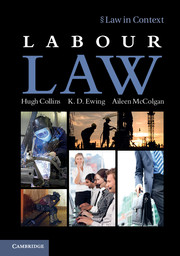Book contents
- Frontmatter
- Contents
- Preface
- Acknowledgments
- Table of cases
- Table of statutes
- Table of statutory instruments
- Table of European Union instruments
- Table of ILO instruments
- Table of other international instruments
- Abbreviations
- Part I Introduction
- Part II The contract of employment
- Part III Statutory regulation of the employment relationship
- Part IV Collective labour rights
- 12 Freedom of association and the right to organise
- 13 Freedom of association and trade union autonomy
- 14 The right to bargain collectively
- 15 The right to be informed and consulted
- 16 Collective action and the right to strike
- 17 Liability for collective action
- Part V Termination of employment
- Index
- References
12 - Freedom of association and the right to organise
from Part IV - Collective labour rights
- Frontmatter
- Contents
- Preface
- Acknowledgments
- Table of cases
- Table of statutes
- Table of statutory instruments
- Table of European Union instruments
- Table of ILO instruments
- Table of other international instruments
- Abbreviations
- Part I Introduction
- Part II The contract of employment
- Part III Statutory regulation of the employment relationship
- Part IV Collective labour rights
- 12 Freedom of association and the right to organise
- 13 Freedom of association and trade union autonomy
- 14 The right to bargain collectively
- 15 The right to be informed and consulted
- 16 Collective action and the right to strike
- 17 Liability for collective action
- Part V Termination of employment
- Index
- References
Summary
Introduction
Much of this work so far has been concerned with different ways by which the law is used to empower and protect workers. We have seen how this may be done through the contract of employment, or through regulatory legislation, which now covers a substantial area. Also important as a source of empowerment and protection, however, is the role of trade unions and the process of collective bargaining. By virtue of the latter, trade unions and employers negotiate collective agreements, which regulate the terms and conditions of employment of the workers to whom they apply. These collective agreements may cover both substantive (pay, hours and holidays) and procedural (grievance and disciplinary procedures) issues. Workers covered by a collective agreement will generally be better paid than their counterparts who are not, while workers who are trade union members will be able to call upon their union for support when problems arise at work. But if workers are to enjoy these benefits, they must be free to join trade unions, to take part in their activities and to use their services. That is to say, they must have the right to organise, a right protecting them from sanctions imposed by the state, or from various forms of discrimination by their employer. The right to organise is the first principle of the right to freedom of association, and is considered in this chapter.
The right to freedom of association is a right of great subtlety, with at least three dimensions:
freedom to be in association with others (in the sense that one may not be restrained or penalised for associating with others);
freedom in the association of others (in the sense that individuals should be free collectively to decide how their association is to be organised and governed); and
freedom to act in association with others (in the sense that individuals should be free to act collectively to promote the purposes that brought them together).
- Type
- Chapter
- Information
- Labour Law , pp. 447 - 489Publisher: Cambridge University PressPrint publication year: 2012



